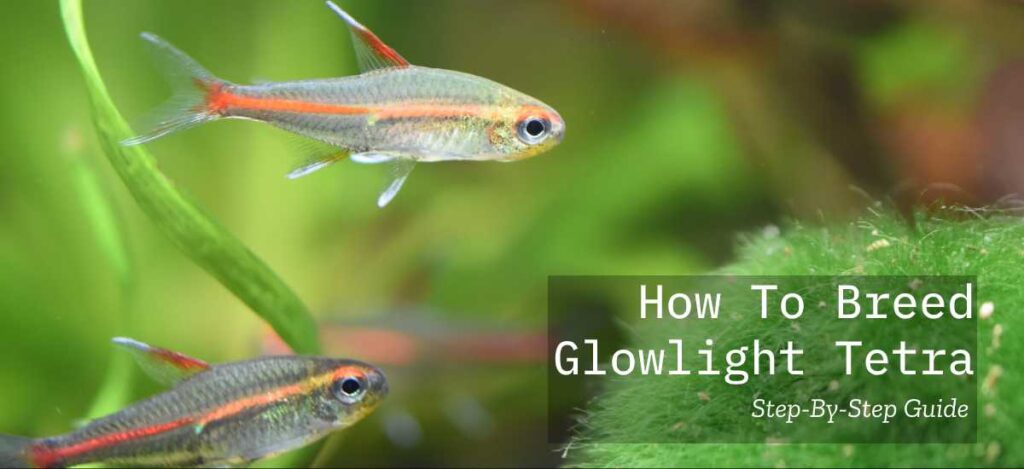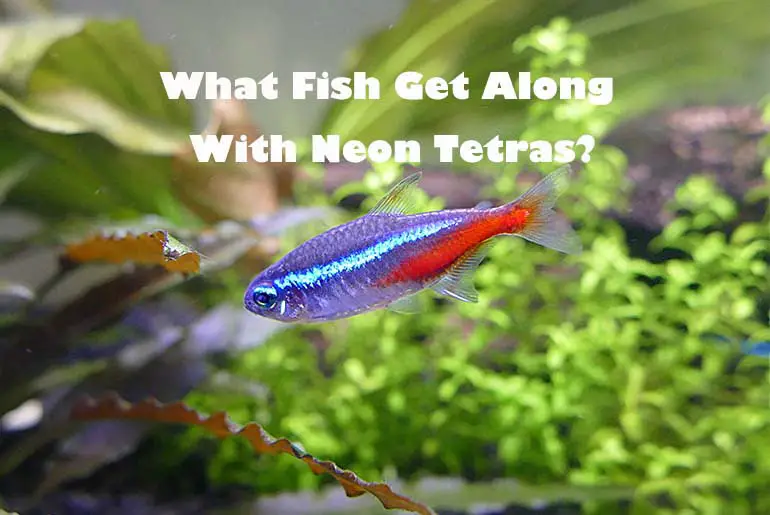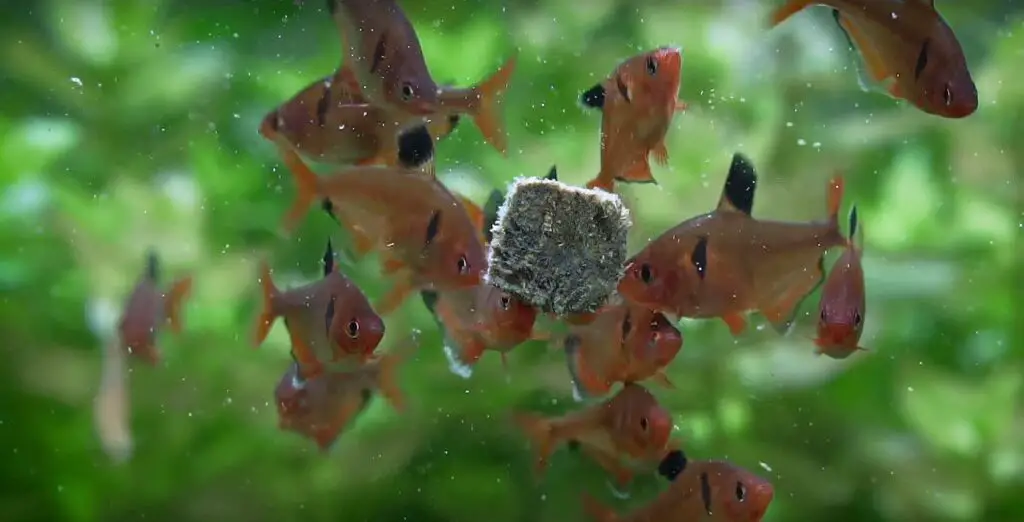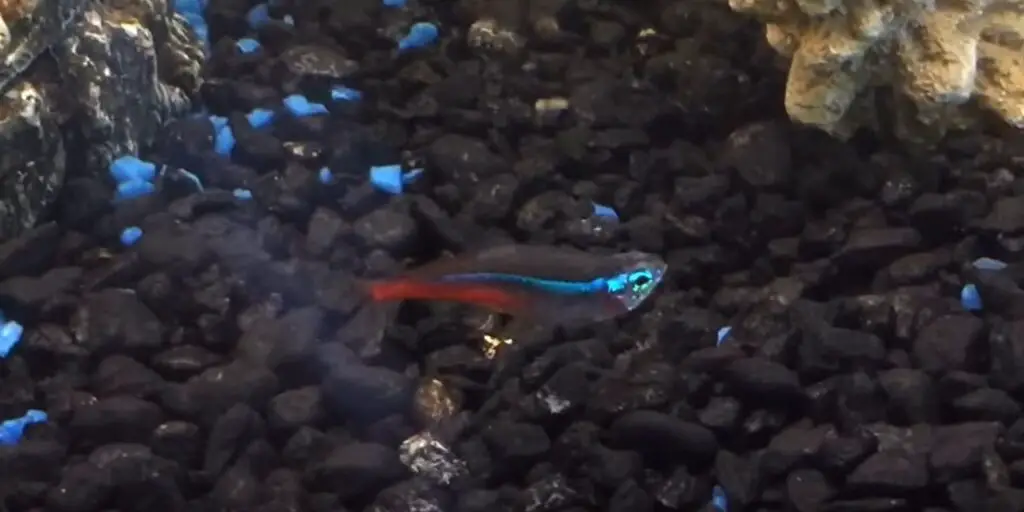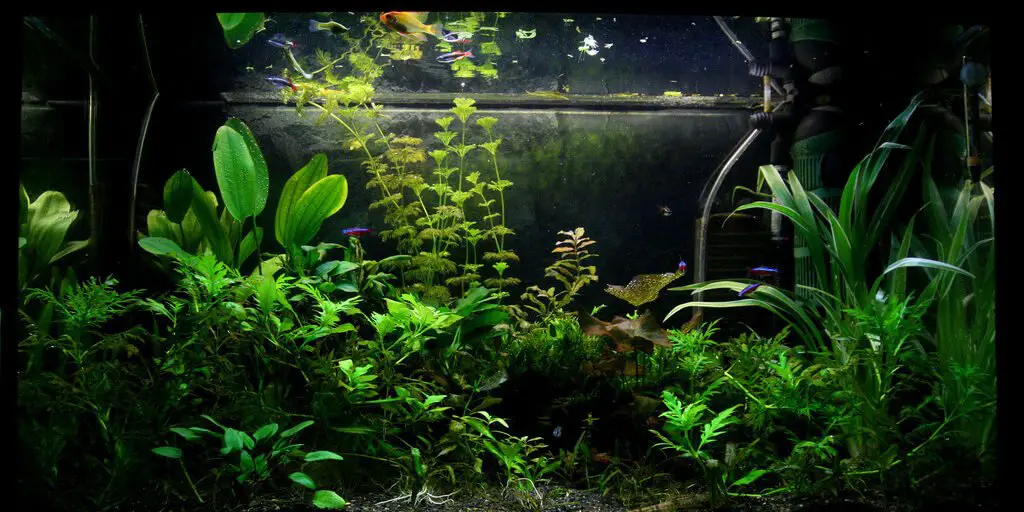Welcome to the fascinating world of breeding Glowlight Tetra fish! Whether you’re a beginner enthusiast or a seasoned aquarist looking to expand your aquatic family, breeding these vibrant and mesmerizing creatures can be a rewarding experience. Glowlight Tetras, known for their radiant hues and peaceful demeanor, are a delightful addition to any aquarium.
In this comprehensive guide, we will delve into the essential aspects of breeding Glowlight Tetras, covering everything from understanding their natural behavior to creating an optimal breeding environment.
Quick Answer:
Breeding Glowlight Tetras involves creating a comfy home mimicking their natural habitat. Make sure to offer safe spots for laying eggs and fry protection. Adjust the water conditions like temperature and pH to encourage breeding. With care and attention, you’ll soon enjoy new baby Glowlight Tetras in your tank.
Equipment You Will Require To Breed Glowlight Tetra
- Aqua Culture 10 Gallon Aquarium Starter Kit
- Sponge Filter and Air Pump
- NICREW ClassicLED Aquarium Light
- Orlushy Submersible Aquarium
- Pawfly 4 Inch Aquarium Net Fine Mesh
- hygger Carbon Fiber 6 in 1 Aquarium Cleaning Tool Kit
- API Master Freshwater Test Kit
Step By Step Process to Breed Glowlight Tetra
Becoming a successful Glowlight Tetra breeder is an exciting journey, made simpler through a step-by-step approach. We’ve segmented this process into three fundamental parts to guide you seamlessly: preparing for breeding, the actual breeding process, and ensuring the best care for the fry once they arrive. Each step plays a vital role in fostering new life and creating a thriving Glowlight Tetra community within your aquarium.
Part 1: Preparing for Breeding
Setting Up A Breeding Tank
- Select the Tank: Choose a breeding tank of appropriate size, typically around 10 to 20 gallons, to ensure enough space for the breeding pair.
- Equip with Essentials: Install a reliable automatic heater to maintain a stable temperature and an air filter for good aeration.
- Create Hiding Spaces: Add decorations, plants such as Java Moss, and Guppy Grass, and suitable hiding spots to reduce stress and mimic the natural habitat.
This provides a comfortable and conducive environment for Glowlight Tetras to breed successfully.
Here is a full comprehensive guide to set up an aquarium for your adult GlowLight Tetra, do check it out.
Breeding Tank Placement
When setting up the breeding tank for Glowlight Tetras, consider their preference for a darker environment, especially during breeding. Here are key tips for tank placement:
- Avoid Direct Sunlight: Choose a location away from direct sunlight exposure, as excessive light can deter Tetras from breeding.
- Opt for Dim Lighting: You can place the tank in a dimly lit room to simulate the darker, natural conditions preferred during breeding.
- Use Light Barriers: To control light levels, you can even cover the tank glass with a cloth or use a light barrier to maintain the desired darkness while allowing periodic checks.
Managing Water Parameters
During their natural breeding season in the rainy months, Glowlight Tetras thrive in conditions mirroring their habitat. The temperature during this period is around 77 degrees Fahrenheit, with the water having low mineral content and a slightly acidic pH, mainly due to rainwater influence.
Here’s how to replicate these conditions in your breeding tank:
- Maintain Temperature: Set the tank temperature to a consistent 77-78 degrees Fahrenheit, aligning with their preferred breeding range.
- Use a Thermometer: Employ an aquarium thermometer to closely monitor and regulate the water temperature.
- Adjust pH Levels: Aim for a pH range of 5-6 to create a slightly acidic environment, similar to their natural habitat.
- Ensure Proper Aeration: Install an air filter and air pump to keep the water well-oxygenated and in circulation, mimicking the conditions Glowlight Tetras prefer during the rainy season.
Obtaining Quality Food
Ensuring your Glowlight Tetra fry receive proper nutrition is like giving them the best start in life. Just like people, fish have unique dietary needs as they grow. I do have a dedicate article on what to feed your Glowlight Tetra fish and how often to feed them. Here is the link to the article, co check it out. Let’s understand how to anticipate these needs and select suitable food options:
- For Our Tiny Newborns:
Imagine your little fry, just hatched and eager to grow! They need delicate, easily digestible foods like powdered fry food, Vinegar Eels, Infusoria, and Green Water to nourish them during this early phase.
- During Their Teenage Days (Juvenile Stage):
As they grow into their teenage days, their appetites and nutritional requirements evolve. Foods like specially formulated fry flakes, newly hatched brine shrimp, and microworms become their go-to meals, packed with essential nutrients for a healthy adolescence.
- Adults and Loving Parents:
In their adult years and for the nurturing parent fish, a varied and nutritious diet becomes crucial. Opt for high-quality fish foods like Tetra Micro Pellets or Tetra Mini for a well-rounded diet that keeps them energetic and vibrant.
Part 2: The Breeding Process
Selecting a Healthy Breeding Pair
To kickstart the beautiful journey of breeding your Glowlight Tetras, you first need to ensure you have a strong breeding pair. Here’s a straightforward approach to help you choose the perfect pair:
- Choose a Reliable Source:
Begin by selecting your fish from a trustworthy and reputable source. A reliable source ensures you have healthy and genetically robust fish, setting the foundation for successful breeding. - Identify Gender Differences:
Distinguishing between male and female Glowlight Tetras is essential. Males tend to be more colorful and have elongated dorsal fins, while females have a rounder belly and less vibrant colors. - Check for Health and Vitality:
Examine the overall health of the potential breeding pair. Look for signs of illness, deformities, or abnormalities. Choose fish that are lively, active, and in prime health. - Quarantine the Fish:
Before introducing the pair to the breeding tank, quarantine them in a separate tank. This step is crucial to prevent the spread of any diseases or infections to other fish in the main tank.
Note that you will be adding the breeding fish to the breeding tank on the 6th day of preparing the breeding tank.
Also Read: How Many Glowlight Tetra To Keep In A Tank
Breeding Signs
Determining if a Glowlight Tetra or any other fish is pregnant is a bit different from mammals like humans. Fish don’t carry their young internally and give birth in the way mammals do. Instead, they lay eggs.
For Glowlight Tetras or other egg-laying fish, you won’t see the traditional signs of pregnancy. Instead, you’ll notice signs of readiness to breed and lay eggs. Females will appear rounder or plumper, particularly when they’re carrying eggs. Additionally, females may display behaviors like seeking out hiding spots and displaying interest in males.
Here are the 7 signs that show your breeding pair of Glowlight Tetras is ready for breeding:
- Vibrant Colors:
Both you’ll notice the male and female Glowlight Tetras displaying vibrant and intensified colors, signaling they are in optimal breeding condition. - Active and Energetic Behavior:
You’ll observe an increase in activity as they chase each other playfully. This heightened energy is a clear sign that they are ready for breeding. - Flaring Fins and Displaying:
The male may flare its fins and display vibrant colors to attract the female, showcasing classic courtship behavior. - Nesting Behavior:
The male may start building a bubble nest at the water’s surface or search for potential nest sites, showcasing nesting instincts. - Chasing and Courtship Rituals:
You’ll witness the male chasing the female in a circular dance or zigzag pattern, indicating courtship and readiness for breeding. - Eager for Proximity:
The male may position itself near the female and try to stay close, showcasing a desire to initiate the breeding process. - Frequent Posing:
Both the male and female will assume specific postures, such as an S-shape or head-down position, during the courtship, signaling their readiness.
Egg Fertilization
After the courtship begins, the next significant event is the egg fertilization process. As the female Glowlight Tetra expels her eggs into the water, both fish often roll onto their backs. This spawning process, typically lasting 1-2 days and occurring for about 1-2 hours, is a crucial phase. It’s essential to keep the tank in darkness during this time.
The Java Moss or Guppy Grass placed earlier in the tank now serves as the spawning site for the fish. This site should cover approximately ¾ of the total tank space. The number of eggs released usually ranges from 50 to 500, influenced by the female Glowlight Tetra’s age and reproductive level.
Following the egg expulsion, the male Tetra takes on the role of fertilizing the eggs. However, if the spawning process doesn’t initiate after 2-3 days of attempting, it’s advisable to separate the pair and introduce them to different ready-to-breed Glowlight Tetras.
While this may sound technical, witnessing the actual spawning is undeniably a beautiful and awe-inspiring moment!
Removing Breeding Pair
Moving forward, once the spawning process is complete, it’s crucial to remove the breeding pair from the tank. Glowlight Tetras have a tendency to consume their own eggs, especially in smaller breeding tanks, which could result in an empty tank devoid of eggs. To mitigate this, immediate removal of the pair is highly recommended.
However, if immediate removal isn’t feasible, a useful strategy to protect the eggs involves placing a piece of craft mesh over the tank’s bottom. This mesh acts as a barrier, effectively trapping the eggs and preventing the parents from accessing and consuming them. It’s a valuable precaution to ensure the survival of the eggs during this critical period.
Monitoring Eggs
Moving on to the crucial step of monitoring the eggs, it’s essential to recognize that not all eggs are successfully fertilized. Some may be contaminated or unfertilized, which necessitates their removal from the breeding tank.
After the fertilization process, you’ll notice a discernible change in the eggs. Fertilized eggs will develop a distinctive black dot at their center, typically within their transparent or slightly yellowish appearance.
To ensure the healthy growth of the viable eggs, it’s imperative to diligently remove any unfertilized or infected eggs. Allowing these eggs to remain can compromise the water quality, potentially harming the healthy, developing eggs. Keeping a close eye on the eggs and maintaining their environment is key to a successful breeding process.
Part 3: Caring For The Fry
Hatching Of The Egg
Now, let’s delve into the critical stage of hatching. After approximately 2 to 3 days of incubation, you’ll begin to observe subtle movements within the eggs as the fry inside attempt to break free.
Upon hatching, the fry will initially appear restless, tending to stay at the tank’s bottom. They’ll carry an egg sac attached to their bellies, providing them with initial sustenance. It’s important to refrain from feeding them during this stage, as offering food can contaminate the tank and jeopardize the fry’s delicate state.
As the fry gradually absorb the egg sac, gaining strength and vitality, they’ll begin to explore their tank environment. This period marks a crucial transition, setting the stage for their growth and development.
Feeding Glowlight Tetra Fry
Feeding the Glowlight Tetra fry is a pivotal aspect of their growth. Initially, as tiny newborns taking their first swims, they require delicate and easily digestible foods like powdered fry food, infusoria, or green water. These micro foods provide essential nutrition during this crucial early phase.
As they progress through their juvenile stage, transitioning into their teenage days, their appetites and nutritional needs shift. Foods such as specially formulated fry flakes, newly hatched brine shrimp, and microworms become their primary meals, enriched with vital nutrients to support a healthy adolescence.
As the fry further mature into adulthood, and for the nurturing parent fish, a diversified and nutritious diet is essential. Opt for high-quality fish foods like Tetra Micro Pellets or Tetra Mini, ensuring a well-rounded diet that sustains their energy levels and vibrant health. Adapting their diet at each stage to their specific nutritional requirements is crucial for their overall well-being and growth.
Maintaining The Water Condition Of the Fry Tank
Maintaining the water conditions for your fry tank is vital for their healthy development. Aim for a pH range between 5.8 and 6.8, ensuring a slightly acidic to neutral environment. Moderate hardness, ideally between 3 to 5 dGH (degrees of General Hardness), supports their well-being.
Additionally, regulate the temperature within a comfortable range of 75° to 80° F (24° to 27° C), providing an optimal environment for their growth and vitality. To uphold water quality, conduct regular water changes of at least 25 to 50% every week, guaranteeing a clean and conducive habitat for the fry to thrive and mature.
Once they reach their adulthood, you now can shift them to your main tank with other community fish. If you want to learn about the best tank mates for Glowlight Tetra, do check it out. I highly recommend you to read the article as there are fish that seems to be great addition to the tank, but aren’t.
Troubleshooting and Common Issues:
Here’s a guide for each potential issue related to breeding Glowlight Tetras:
Egg Fungus and Contamination:
Issue:
If you notice fungus or contamination affecting the eggs, it can harm their development and survival.
Solution:
- Remove contaminated eggs promptly using a gentle siphon or tool to maintain water quality.
- Utilize antifungal treatments safe for aquarium use to combat egg fungus.
- Ensure a clean breeding environment and good water quality to prevent contamination.
Male Aggression:
Issue:
Aggressive behavior from the male towards the female or eggs can disrupt the breeding process.
Solution:
- Introduce more hiding spots and plants to the breeding tank to offer escape routes for the female.
- Separate overly aggressive males to maintain a calm breeding environment.
- Ensure proper tank size and balance to reduce aggression.
Unsuccessful Spawning:
Issue:
Sometimes, the breeding pair may fail to spawn, delaying or hindering the breeding process.
Solution:
- Check and adjust water conditions, including temperature and pH, to align with their natural breeding preferences.
- Offer a varied diet and maintain optimal tank conditions to encourage a successful breeding attempt.
- Consider changing partners if unsuccessful attempts persist.
Parental Neglect:
Issue:
Parents may neglect their eggs or fry, risking their survival and growth.
Solution:
- Provide a suitable environment with sufficient hiding places for fry to encourage parental care.
- If neglect occurs, carefully transfer the eggs or fry to a separate tank and provide appropriate care until they can fend for themselves.
Diseases and Infections:
Issue:
Diseases or infections can hinder the breeding process and endanger the health of the fish.
Solution:
- Quarantine new fish before introducing them to the breeding tank to prevent disease transmission.
- Maintain a clean tank with good water quality, regular water changes, and a balanced diet to bolster immune systems and prevent diseases.
Learn more about Glowlight Tetra Disease and Treatment.
Inadequate Fry Survival:
Issue:
Low survival rates among fry can be due to inadequate care, nutrition, or environmental conditions.
Solution:
- Provide appropriate fry food, suitable tank conditions, and regular feeding to enhance survival rates.
- Minimize stress by maintaining stable water parameters and a peaceful tank environment.
Stress Management:
Issue:
High stress levels among breeding glowlight tetras can adversely affect the breeding process.
Solution:
- Minimize disturbances and maintain a quiet, stress-free environment during the breeding period.
- Keep water parameters stable, avoid sudden changes, and maintain proper filtration and aeration to reduce stress.
Some of The Question Related to Breeding Glowlight Tetra
Will Glowlight Tetra Breed in Home Aquarium?
Yes, glowlight tetras can breed successfully in a well-maintained home aquarium.
How Often Does Glowlight Tetra Breed?
Glowlight tetras can breed multiple times a year, often triggered by environmental conditions and suitable tank setup.
Are Glowlight Tetras Easy to Breed?
With proper care and the right conditions, glowlight tetras are relatively easy to breed in a home aquarium.
What do Pregnant Glowlight Tetras Look Like?
Female glowlight tetras with developing eggs may appear rounder and slightly swollen in the belly area.
When Will Glowlight Tetras Lay Eggs?
Glowlight tetras typically lay eggs during their active breeding period, often triggered by specific environmental conditions and courtship behavior.
What do Glowlight Tetra Eggs Look Like?
Glowlight tetra eggs are small, clear, and spherical in shape, often slightly adhesive to surfaces like plants or tank walls.
How Long Does it Take for Glowlight Tetra Eggs to Hatch?
Glowlight tetra eggs usually hatch within 24 to 48 hours after being laid, depending on water temperature and conditions.
Summing Up
Breeding Glowlight Tetras is a captivating adventure, and watching the Glowlight Tetra fry grow adds a whole new dimension to the experience. These tiny wonders, as delightful to observe as they are, also come with the advantage of being relatively easy to care for. Ensuring ample live plants for them to seek refuge in significantly reduces their stress levels, contributing to their growth and vitality.
Your experiences and insights are invaluable to us. If you have questions, stories, or suggestions to share, we invite you to join the discussion in the comments below. Your engagement enriches our community and helps fellow aquarists in their own breeding endeavors. Embrace this enchanting journey, and may your tank soon be bustling with the vibrant glow of new life!
